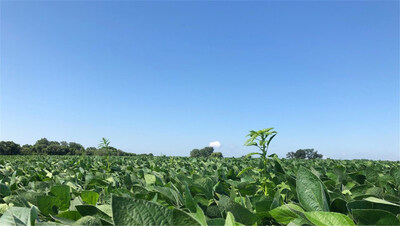Research Shows Waterhemp Resistance Can Evolve from Preemergent PPO Inhibitor Use
A new Weed Science Society of America research article highlights the need for stewardship to preserve PPO-inhibitor herbicides as an effective waterhemp control option
WESTMINSTER, Colo., Oct. 23, 2025 /PRNewswire/ -- A recently published research article in the journal Weed Science shows that waterhemp resistance to protoporphyrinogen oxidase (PPO) inhibitor (Group 14) herbicides can develop from soil-applied preemergence applications, and not just from postemergence herbicide use. PPOs are an important herbicide type that work by blocking a key enzyme necessary for chlorophyll production in plants. The research occurred during 2022 and 2023 at the University of Wisconsin–Madison, Madison, Wisconsin.
Former Ph.D. student Felipe de Andrade Faleco led the study, with sponsorship from the Wisconsin Soybean Marketing Board in partnership with Pat Tranel, Ph.D., Professor of Molecular Weed Science at the University of Illinois Urbana-Champaign, and his lab. "Our research documented the first confirmed case of a waterhemp population in Wisconsin that can survive PPO-inhibiting herbicides applied preemergence," says Rodrigo Werle, Ph.D., WSSA member, corresponding author, and University of Wisconsin-Madison Associate Professor and Extension Cropping Systems Weed Scientist. "Until now, most reports of PPO resistance in waterhemp were related to postemergence applications – herbicides sprayed after weeds emerge. This finding shows that waterhemp resistance can also evolve from soil-applied, preemergence herbicides."
Preemergence PPO herbicides, such as sulfentrazone (Spartan) and fomesafen (Flexstar), have become very important to control waterhemp populations that are already resistant to other herbicide groups applied postemergence, points out Werle. He adds that waterhemp is a major weed problem across the U.S. Midwest, and that farmers throughout this region rely heavily on preemergence products for weed control.
"Discovering resistance at the preemergence level is concerning because it limits one of the remaining effective chemical options for early season waterhemp control," cautions Werle. "This serves as an early warning to growers to diversify their weed management programs before similar resistance spreads. For researchers, it signals the need to better understand how this resistance develops over time so that we can design more effective, long-term management strategies."
Currently, farmers can help delay resistance by applying full-labeled rates, tank-mixing PPO-inhibitor herbicides with other effective preemergence herbicide groups, and integrating non-chemical tactics such as crop rotation, cover crops, and other cultural or mechanical control practices, advises Werle. "Reducing reliance on a single herbicide mode of action is key to sustaining their performance in the field," he emphasizes.
More information about the study is available in the article: "Resistance to protoporphyrinogen oxidase inhibitors applied preemergence or postemergence to waterhemp (Amaranthus tuberculatus). The research article is among other research articles recently featured online in Weed Science, a Weed Science Society of America journal, published by Cambridge University Press. Werle can be contacted about the study at rwerle@wisc.edu.
About Weed Science
Weed Science is a journal of the Weed Science Society of America, a nonprofit scientific society focused on weeds and their impact on the environment. The publication presents peer-reviewed, original research related to all aspects of weed science, including biology, ecology, physiology, management, and control of weeds. To learn more, visit www.wssa.net.
![]() View original content to download multimedia:https://www.prnewswire.com/news-releases/research-shows-waterhemp-resistance-can-evolve-from-preemergent-ppo-inhibitor-use-302592282.html
View original content to download multimedia:https://www.prnewswire.com/news-releases/research-shows-waterhemp-resistance-can-evolve-from-preemergent-ppo-inhibitor-use-302592282.html
SOURCE Weed Science Society of America


![This image shows the response of suspected PPO-inhibitor–resistant [A92 (R)] and known susceptible [A66 (S)] waterhemp (Amaranthus tuberculatus) populations from Wisconsin, 28 days after treatment with soil-applied sulfentrazone (Spartan), fomesafen (Flexstar), and flumioxazin (Valor) at 0×, 0.125×, 0.25×, 0.5×, 1×, 2×, 4×, and 8× the labeled rate. NTC = non-treated control. Photo credit: Dr. Felipe de Andrade Faleco, former Ph.D. student, University of Wisconsin–Madison. This image shows the response of suspected PPO-inhibitor–resistant [A92 (R)] and known susceptible [A66 (S)] waterhemp (Amaranthus tuberculatus) populations from Wisconsin, 28 days after treatment with soil-applied sulfentrazone (Spartan), fomesafen (Flexstar), and flumioxazin (Valor) at 0×, 0.125×, 0.25×, 0.5×, 1×, 2×, 4×, and 8× the labeled rate. NTC = non-treated control. Photo credit: Dr. Felipe de Andrade Faleco, former Ph.D. student, University of Wisconsin–Madison.](https://mma.prnewswire.com/media/2803144/WS_Oct2025_PR_photo.jpg)

